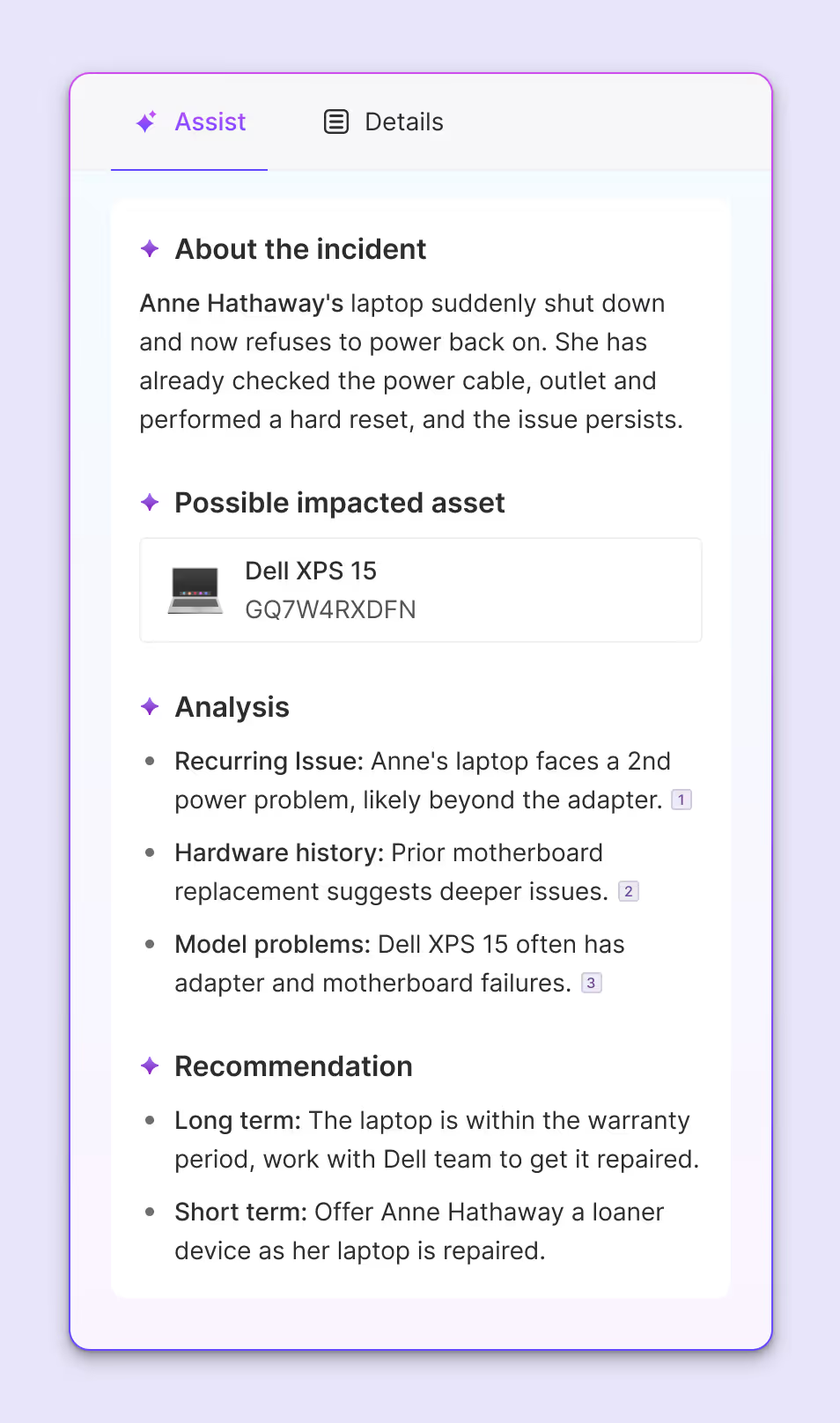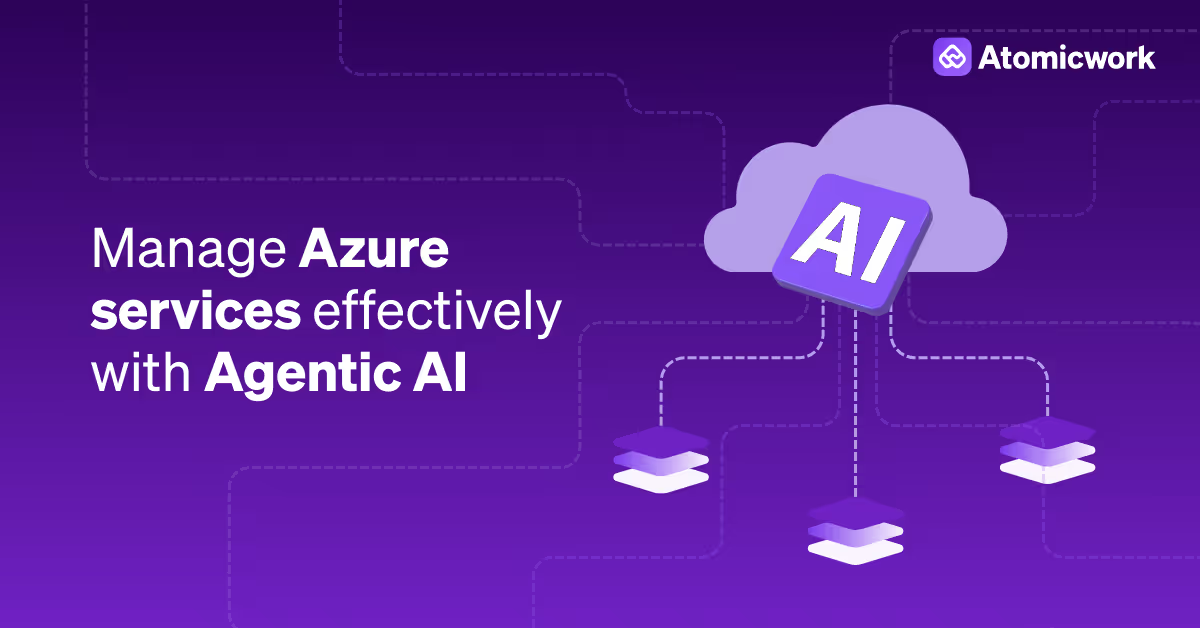25+ AI prompts for IT Support Teams [By a busy sysadmin]

Imagine you're staring at a PowerShell error at 2 AM, or racing to patch 50 servers before Monday morning. As a system admin handling 100+ devices, I can relate, and honestly, this is exhausting!
Modern GPTs could solve this in seconds, but only if you know how to ask it the right way.
We often spend a significant amount of time resolving vague AI responses when precise prompts could generate working scripts, decode cryptic error messages, or draft professional yet easily-understandable policy docs and emails instantly.
Knowing how to communicate with LLMs effectively has helped me look at GPTs from a different perspective: from a shiny AI hype to my most reliable troubleshooting partner.
Here are the exact AI prompts–broken down by 9 common scenarios–that we use at Atomicwork to cut through ticket backlogs, solve problems faster, and drive production-ready results in minutes.
#1 Patch validation and self-healing
After patching 30 servers overnight, you need to verify that everything came back up correctly without manually checking each one.
Why it works: Combines validation with automated remediation steps, which mirrors real post-patch workflows where admins need both detection and immediate response capabilities.
Prompt 1:
Create a bash script that validates if critical patches were applied successfully after reboot.
Check if:
1) System uptime is recent,
2) All services from a predefined list are running,
3) Network connectivity to 3 test endpoints,
4) Log file does not contain specific error patterns.
If any check fails, log the issue and send a notification. Include rollback suggestions.
Prompt 2:
Write a PowerShell script for Windows patch validation that verifies:
Pending reboot status, status of critical services that are running, Windows Update history, and system event logs for errors.
Auto-restart failed services and generate compliance report.
Prompt 3:
Build a comprehensive post-maintenance validation script that tests:
database connectivity, web service endpoints, file share accessibility, and backup job status.
Include automatic remediation steps.
Your output should have multi-layered validation checks, automated service recovery, detailed logging, and rollback procedures.
#2 Troubleshooting assistance
When you're staring at cryptic error messages or dealing with intermittent system issues, GPTs acts as your patient debugging partner.
Why it works: Provides a structured methodology for complex problem-solving, while explaining the reasoning behind each diagnostic step, especially when you're dealing with multiple incidents at the same time.
Prompt 4:
Help me troubleshoot this error:
"Event ID 4625 - An account failed to log on" appearing frequently in Security logs.
Provide:
1) Most likely causes,
2) Step-by-step diagnostic approach,
3) PowerShell commands to investigate,
4) Remediation steps
Prompt 5:
I am seeing high CPU usage on SERVER01 but Task Manager shows no obvious culprit.
Walk me through systematic troubleshooting steps including command-line tools, log files to check, and performance counters to monitor.
Prompt 6:
Network connectivity is intermittent between VLAN 10 and VLAN 20.
Users report random timeouts. Provide a structured troubleshooting methodology from Layer 1 to Layer.
This should inlude specific commands and tests.
Prompt 7:
Explain this PowerShell error and suggest fixes: "Cannot bind argument to parameter 'Path' because it is null."
Here is my script for reference: [paste code here]
These AI prompts can help you with systematic diagnostic approaches, command-line troubleshooting tools, root cause analysis frameworks, and step-by-step remediation plans.
Pro tip: Modern service management platforms like Atomicwork are bringing this type of troubleshooting assistance for IT support teams at real-time right within the support portal where you view the request or incident details.
What's more interesting is that customized AI agents like Atom, triage the incident details with layered context about the user's past requests, device details, and location information for a more in-depth and contextual root cause analysis.

#3 Ticket triage and auto-routing
When you're overwhelmed by a queue of 47 unassigned tickets, you need to categorize and route issues promptly to prevent them from escalating quickly.
Why it works: Forces GPTs to think like a tier-2 technician by breaking down analysis into structured categories you need for escalation decisions.
Prompt 8:
Act as a tier-2 support analyst.
Review this ticket and determine: priority level, technical category, responsible team, and immediate diagnostic actions needed.
Ticket details: [paste here]
This prompt gives a structured severity assessment, root cause categories, team routing decisions, and prioritized troubleshooting steps.
While most organizations have automated ticket triaging and routing built into their ITSM systems, we've taken it as step further at Atomicwork. We wanted to support our employees in the flow of their work. Our backend ticketing system (the Atomicwork portal) is integrated with Slack so that end users can raise their IT issues and HR or Finance requests directly on Slack.
Atom, our Universal Agent, resolves most simple queries effortlessly on Slack and complex ones get routed to me and my team with priority and team member assigned automatically based on the routing logic.
#4 PowerShell/Bash script generation
You know precisely what you want the script to do, but writing it from scratch means 30 minutes of syntax lookups and testing.
Why it works: Provides specific requirements upfront, including error handling and output format, which prevents GPT from generating basic scripts that break in real environments.
Prompt 9:
Write a PowerShell script that:
Checks disk space on remote servers from a text file list,
Outputs results to CSV, and
Sends email alert if any server has less than 15% free space.
Include error handling for unreachable servers. Use generic server names like SERVER01, SERVER02.
Prompt 10:
Create a bash script to:
Monitor system resources (CPU, memory, disk) on multiple Linux servers,
Log results with timestamps, and
Trigger alerts when thresholds exceed 80%
Include service restart capability.
Prompt 11:
Build a monitoring script that:
Tests website availability,
Checks SSL certificate expiration dates, and
Sends Slack notifications for issues.
Support both Windows and Linux environments.
These prompts can help you with working scripts with error handling and logging, which you can then tweak rather than starting from a blank state.
#5 Active Directory onboarding and offboarding
Whether you need you have long spreadsheet of employees to onboard or need to swiftly handle employee terminations quickly, you need to secure access immediately while maintaining an audit trail for compliance purposes.
Why it works: Follows proper off boarding sequence with audit trail creation, which addresses compliance requirements that GPTs might otherwise miss without explicit guidance.
Prompt 12:
Generate a PowerShell script for bulk user creation from CSV input.
Include password generation, OU placement, group assignment, and error logging for failed accounts.
Prompt 13:
Build a bulk user modification script that:
Processes CSV input to update department changes, group memberships, and manager assignments while maintaining audit logs of all changes.
Prompt 14:
Write a compliance audit script that:
Reports on inactive accounts, accounts with non-expiring passwords, users with admin privileges, and generates executive summary with recommendations.
#6 Incident post-mortem drafting
Your CEO wants a detailed incident report by the end of the day, but you're still fighting fires and don't have time to craft professional documentation.
Prompt 15:
Draft an incident post-mortem report using this template:
**Incident Summary** (2-3 sentences),
**Timeline** (key events with timestamps),
**Root Cause** (technical detail),
**Impact Assessment** (users/systems affected),
**Immediate Actions Taken**,
**Lessons Learned**,
**Action Items** (with owners and due dates),
Use this incident data: [paste your incident details here]
Prompt 16:
Create an executive briefing document for this outage:
Focus on business impact,
Customer communication guidelines, and
Prevention measures.
Keep technical details minimal and emphasize lessons learned and improvement commitments.
Incident details: [paste here]
Prompt 17:
Generate a technical deep-dive incident report for engineering teams including:
Detailed timeline,
Root cause analysis,
System architecture diagrams needed,
Monitoring gaps identified, and
Specific technical remediation steps.
#7 Documenting policies
Having clear policies in place reduce ambiguity, ensure consistency, and help organizations meet legal or regulatory requirements. They also reduce the dependency on individual sysadmins by creating reusable guidance for recurring scenarios.
When AI assists with drafting, sysadmins can generate comprehensive IT policies and procedures without starting from blank pages or spending hours researching compliance requirements.
Why it works: It ensures that policies are both comprehensive and easy to understand for non-technical stakeholders, making adoption easier and reducing back-and-forth clarification.
Prompt 18:
Create a formal contractor onboarding policy for our IT department.
Include sections on account creation, access permissions, security responsibilities, and offboarding procedures.
Write it in clear, non-technical language so managers can understand and follow it easily.
Prompt 19:
Write a Data Backup and Recovery Policy that addresses:
Backup schedules,
Retention periods,
Testing procedures,
Recovery time objectives, and
Compliance requirements for healthcare data.
Prompt 20:
Acceptable Device Use Policy
Generate an acceptable use policy for company-issued laptops and networks.
Include sections on:
Permitted and prohibited activities,
Responsibilities for protecting company data, and
Consequences of violations.
Keep it concise but comprehensive enough for all employees to understand.
#8 Clear e-mail communication
As sysadmins, we need to communicate time-sensitive updates like security changes, system outages, or deploying new tools to employees. These emails prevent confusion, reduce support ticket spikes, and encourage faster adoption of changes.
If messages get too technical, employees may ignore or misunderstand them, leading to policy non-compliance or downtime.
Why it works: GPTs help sysadmins write concise, business-friendly emails that clearly explain why a change is happening, when it matters, and what employees need to do. This saves time, maintains consistency, and ensures better change communication with large, non-technical audiences.
Prompt 21:
Write an email to all employees announcing planned VPN maintenance this </insert day of the week>
from </insert timings>.
Include why the maintenance is happening, the expected downtime, and what employees should do if they need access during this period.
Keep it clear and non-technical.
Prompt 22:
Draft an email announcing that MFA will become mandatory for all remote logins starting next Monday.
Explain why this change is being made, provide clear setup steps, and include a link to the setup guide.
Use a friendly and encouraging tone.
Prompt 23:
Create an email notifying employees about a critical security patch that requires all laptops to be restarted tonight.
Explain the importance of the update in simple terms, give instructions on how to restart, and add a deadline for completion.
#9 Learning and knowledge
This is something I personally love about prompting GPTs. Whether a new patch roll out happens from vendors or there's a new upcoming technology that the IT team needs stay updated on, LLMs help curate and break down knowledge on complex technologies without having to start with lengthy documentation.
Why it works: Acts as an infinitely patient mentor that adapts explanations to your existing knowledge level and provides hands-on examples.
Prompt 24:
Explain Kubernetes networking to a Windows administrator.
Focus on concepts like pods, services, and ingress controllers.
Use analogies to Windows networking concepts where helpful.
Prompt 25:
I need to understand this PowerShell code I inherited.
Explain what each section does and identify any potential security risks or improvement opportunities: [paste code here]
Prompt 26:
Compare these two configuration files.
Explain the key differences, potential compatibility issues, and which settings I should prioritize.
[paste config files]
Prompt 27:
Teach me regex patterns for log analysis.
Start with basic concepts and build up to complex patterns for parsing IIS logs, Windows Event logs, and syslog entries.
Include practical examples.
Looking ahead: Expanding the scope of using AI in IT
While LLMs excels at generating scripts and documentation, I'm excited about the next big step here: computer-using agents (CUAs). AI that actually executes tasks across your systems.
CUAs see your screen like a human operator, navigating interfaces and adapting to unexpected changes. While prompts help you work faster, CUAs let your infrastructure manage itself while you and I can focus our efforts on contributing to the org's IT strategy, or... or finally take that vacation we’ve been putting off for months!
You may also like...


































